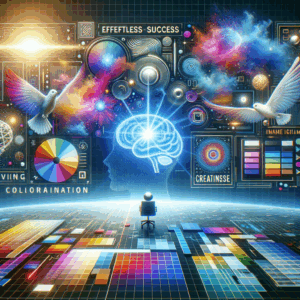
AI Typography: Stunning Innovations For Future Design
- The Rise of AI Typography
- How AI Influences Font Creation
- The Role of Machine Learning in Typography
- Personalization and Customization with AI
- Exploring Responsive Typography
- Trends in AI Typography
- 1. Custom Typefaces
- 2. Dynamic Typography
- 3. Minimalism
- 4. Experimental Fonts
- 5. Multi-Device Compatibility
- The Future of AI Typography
- Conclusion: Embracing AI in Typography
- FAQs
- References
The Rise of AI Typography
In recent years, artificial intelligence (AI) has revolutionized various creative fields, and typography is no exception. Designers are now harnessing AI to create stunning typefaces, enhance readability, and customize fonts for different contexts. This wave of innovation isn’t just changing how we view text; it’s transforming how we interact with it. AI typography is more than a trend; it represents a new frontier in design, blending artistry with technology.
Typography has always played a crucial role in visual communication. Whether it’s for branding, advertising, or user experience, the choice of font can significantly impact perception and engagement. As designers increasingly use AI tools to develop typefaces, they unlock new possibilities for creativity and utility. This convergence of technology and artistry offers exciting opportunities to explore the future of design.
The integration of AI into typography also paves the way for customization. In an era where brands seek to stand out, unique typefaces can elevate identity. AI-driven typography allows designers to generate infinite variations of fonts in mere seconds. This capability empowers creatives to focus on storytelling and user engagement instead of being bogged down by repetitive tasks.
How AI Influences Font Creation
AI algorithms transform font creation into a streamlined process. These sophisticated technologies analyze existing typefaces, learn from them, and then generate new designs based on this information. Rather than starting from scratch, designers can rely on AI systems to provide them with fresh ideas and variations.
For instance, tools like Fontself and Glyphr Studio allow users to create custom fonts quickly. Designers can simply draw their letters, and the software uses AI to refine these sketches into professional-grade fonts. As a result, individuals with little to no design experience can produce unique typefaces that enhance brand recognition.
Moreover, AI-driven typography is not confined to simply generating new fonts. It also focuses on improving legibility and usability. Tools like Adobe Sensei use machine learning to analyze how users interact with text, helping designers choose the optimal typography for specific audiences. This feature enhances user experience, making information more accessible.
The Role of Machine Learning in Typography
Machine learning is a core component of AI that plays a pivotal role in typography. By analyzing vast datasets of fonts and user interactions, machine learning models can offer insights that guide design decisions. This analysis informs designers about which fonts resonate best with particular demographics, contexts, or media types.
In typography, machine learning can identify patterns in how people read. For example, by examining the speed at which users comprehend text set in different fonts, AI can suggest designs that enhance readability. Such insights aid in creating user-centered designs, whether for websites, apps, or print media.
Furthermore, machine learning enhances the adaptability of fonts. Variable fonts, which allow for dynamic adjustments in weight, style, and width, are becoming increasingly popular. AI can optimize these parameters based on the context of use, ensuring that the typography matches the tone and message of the content.
Personalization and Customization with AI
Customizing typography has never been easier. AI plays a crucial role in enabling brands to tailor fonts to their specific needs. By analyzing a brand’s identity and target audience, AI can suggest typefaces that create a perfect fit. This process not only elevates branding but also enhances user engagement.
Tools like Typeface and FontJoy offer designers the ability to manipulate typography effortlessly. These platforms allow users to input their preferences and generate customized font pairs. As a result, designers can experiment with a range of possibilities, ensuring a harmonious blend of type styles.
Moreover, AI can facilitate real-time customization. Imagine a website where the font changes based on the user’s behavior or preferences. AI enables this level of personalization, delivering a more engaging experience. Users feel more connected when the typography speaks directly to their interests and needs.
Exploring Responsive Typography
Responsive design is an essential aspect of modern web development, and typography is no exception. With AI, responsive typography adapts effortlessly to different screen sizes and media types. This adaptability ensures that text remains legible and visually appealing, regardless of the user’s device.
AI tools can analyze user behavior and screen dimensions to determine the optimal typography for various contexts. For instance, a font that works well on desktop screens may not be ideal for mobile devices. AI helps designers fine-tune these choices, ultimately enhancing user experience.
Furthermore, adaptive typography can change not only in size but also in style. A website could switch to a bolder, more attention-grabbing font when users scroll a certain way. This interactivity creates a dynamic experience that keeps users engaged, making AI-driven typography an essential component of modern design.
Trends in AI Typography
AI-driven typography has sparked several exciting trends within the design community. These trends reflect the growing influence of technology on creative processes, leading to innovative results. Understanding these trends can help designers stay ahead of the curve.
1. Custom Typefaces
Brands are increasingly opting for custom typefaces. AI-enabled tools make it easier to create these unique fonts, which stand out in a crowded market. This personalization assures customers of a brand’s individuality.
2. Dynamic Typography
Dynamic typography allows text to change size or style based on user interaction. This trend enhances readability and keeps visitors engaged. AI makes it simple to implement these changes, ensuring a seamless experience.
3. Minimalism
Simplicity in design continues to remain popular, and typography plays a critical role here. Clean, minimalist fonts focus on readability, making them a favorite choice in many designs. AI can suggest minimalist typefaces based on brand identity.
4. Experimental Fonts
With AI’s help, designers are experimenting more than ever. Unconventional typefaces can attract attention and convey emotion effectively. AI-generated suggestions can inspire creativity, allowing designers to push boundaries.
5. Multi-Device Compatibility
AI enhances typography’s adaptability across multiple devices. Designers can create fonts that remain legible and aesthetically appealing, regardless of device type. This trend aligns with the increasing use of mobile and tablet browsing.
The Future of AI Typography
As we look ahead, the potential for AI typography is limitless. The fusion of creativity and technology is reshaping how we perceive and interact with text. As AI continues to evolve, it will undoubtedly create even more astonishing innovations in typography.
One promising area is augmented reality (AR) and virtual reality (VR). These technologies can incorporate dynamic typography in immersive experiences. Imagine navigating a virtual space where typography adapts to your movements or actions. AI can create these experiences seamlessly.
Furthermore, AI will likely enhance accessibility in typography. As society increasingly prioritizes inclusivity, AI can generate typefaces that cater to individuals with visual impairments. These efforts will ensure that typography serves all users effectively.
The landscape of design will continue to change. Traditional typography rules will bend under the influence of AI innovations. Designers will need to adapt and embrace these changes to remain relevant. The future promises to be exciting, rich with potential for creativity and engagement.
Conclusion: Embracing AI in Typography
AI typography represents a thrilling synthesis of technology and creativity. As designers leverage AI tools to improve typography, they enhance user experience, elevate brands, and empower themselves in the design process. By embracing these innovations, the design community can ensure a future filled with creativity, individuality, and engagement.
AI typography is more than just a buzzword; it’s a movement that’s reshaping how we think about text. The path forward is vibrant, inviting designers to explore uncharted territories. By staying informed and adapting to these trends, creatives can set the stage for the next exciting chapter in typography.
FAQs
1. What is AI typography?
AI typography involves the use of artificial intelligence to create, customize, and adapt typefaces, optimizing readability and user experience.
2. How does AI enhance font creation?
AI analyzes existing fonts, learns patterns, and generates new designs, allowing designers to quickly produce unique typefaces without starting from scratch.
3. What are variable fonts?
Variable fonts allow for dynamic adjustments in weight, style, and width, optimizing typography based on the context of use.
4. How can I create my own AI-generated font?
Tools like Fontself and Glyphr Studio enable users to create custom fonts easily by drawing characters, which AI then refines into professional-grade fonts.
5. What role does machine learning play in typography?
Machine learning provides insights into user interactions with text, helping designers choose fonts that resonate with specific audiences and enhance usability.
6. How can typography be personalized using AI?
AI analyzes brand identity and user preferences to suggest customized typefaces, ensuring that typography aligns with a brand’s unique voice.
7. What are the emerging trends in AI typography?
Current trends include custom typefaces, dynamic typography, minimalist designs, experimental fonts, and multi-device compatibility.
8. How does responsive typography work?
Responsive typography adapts text to different screen sizes and devices, ensuring legibility and visual appeal through AI analysis of user behavior.
9. What can we expect for the future of AI typography?
The future may include innovations related to augmented reality, enhanced accessibility features, and further blending of creativity and technology.
10. Is AI typography accessible for non-designers?
Yes, many AI tools are user-friendly, enabling non-designers to create custom fonts and leverage AI’s capabilities without extensive design knowledge.
References
1. Adobe Sensei: AI Formats
2. Fontself: Create Fonts with Ease
3. Glyphr Studio: Free Font Creation
4. Variable Fonts Explained
5. Machine Learning in Design
Feel free to reach out if you have any further questions or need more information on AI typography!

